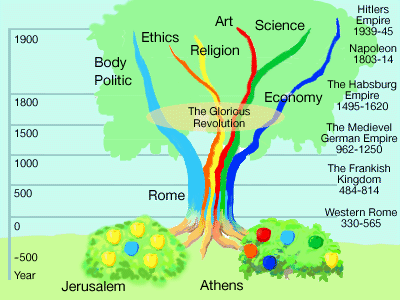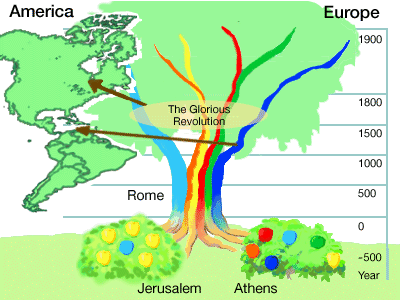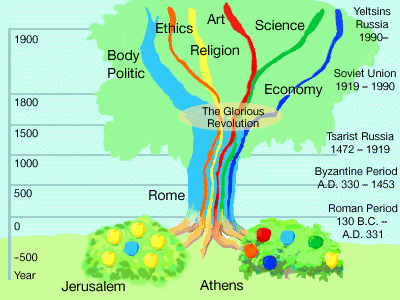Part III. Some Implications
The Decline of the West European Empires
Empires attempting the political integration of Europe have come and gone during the long process of European structuration. A major thesis can now be formulated. The more differentiated the West European society becomes, the shorter the reigns of its empires.

482-814. The Frankish Kingdom lasted some 330 years and included the sixth to the seventh century. Its greatest ruler, Charlemagne, professed himself as "king and priest", and the structuration process we have dealt with here had not began.
962-1250. The medieval German Empire spanned almost 290 years, from the middle of the tenth century to the middle of thirteenth century. It fought, as we have noted, for a draw with the Pope.
1495-1620. The Habsburg Empire of the fifteenth century lasted well over 100 years. A remaining symbol of this empire, El Escorial outside Madrid, was a royal castle, the home of a bureaucracy running most of Europe, a cloister, a propaganda center for the counter-reformation, a necropolis. The empire maintained an ambivalent relation to the church; its greatest ruler, Charles V, voluntarily abdicated to end his life in a monastery. Internal resistance to the empire was greatest in Italy and the Spanish Netherlands, where the differentiation process was most advanced.
1803-1814. The early nineteenth century saw the beginning and end of Napoleon's empire, which lasted for less than 15 years. By this time the contours of an institutionally differentiated society in central Europe were clear. Napoleon's main enemy, England, was the most differentiated country at that time.
1939-1945. Hitler's empire lasted five years in the middle of the twentieth century. He drew resistance not only from political bodies but also from the religious, artistic, scientific and economic communities in an increasingly differentiated Europe.
Obviously, attempts to recreate in Europe anything resembling the Roman Empire in scope become less and less successful and lasting.
The Americas
In Europe's colonial period the its social structure was exported with varying degrees of successes to other continents. In the New World, South America took over an earlier European structure than North America.

The way in which Latin America was structured was from the beginning influenced by experiences from the Iberian peninsula. Charles V's goals for the New Spain were not independent cardinal institutions for politics, religion, and commercial life, but an organic state, hierarchical and harmonious.
The Latin American societies of today retain a foundation of hierarchical institutions that function as protective patrons. Private and public affairs are intertwined; the economy is still often more mercantile than liberal, with many in-between forms of business decisions and political decisions.
The structuration of North America is not identical with that of Europe. There are many European influences but also indigenous ones, for example, the frontier.
The formulation by Thomas Jefferson in the Declaration of Independence of inalienable rights and the statement that "among these are life, liberty and the pursuit of happiness" have well-known antecedents. John Locke had, at the time of the English revolutions, put forth three rights: "life, liberty, and property," or, "life, liberty, and estate."
George Mason, Jefferson's fellow-statesman, had written in the Virginia Declaration of Rights about "the enjoyment of life and liberty, with the means of acquiring and possessing property, and pursuing and obtaining happiness and safety." Jefferson dropped all references to property. He wrote "pursuit of happiness" and added "among these" to the text, implying that there were others.
In Jefferson's own life there is little doubt that the pursuit of happiness was an umbrella covering his pursuits of money, power, knowledge, and artistic beauty as well as his stately family home. He is particularly known for the statement that "the government governs best which governs least," making full room for all non-political pursuits. Lincoln modified this into wiser words, that the government should do for the people whatever the people cannot do for themselves.
In American society government became limited. The Constitution prohibits any alliance between government and religion. Instead the economy grew to be the dominant institution. More often than not, the dollar has a decisive voice in politics, religion, science, and art. Business leaders dominate the boards of directors of universities and museums. In the spirit of F. Scott Fitzgerald, when the heroes in pulp novels stroked the hair of their rich girl friends they could almost hear the crackle of dollar bills. Her perfume carried the scent of money. In today's United States economics usually prevails over all realms of life, even love life. Here is a society in which all the other major institutions are ruled by the economy. In that sense it differs at least in degree from European society.
Yet, because the distinguished ideas of structuration in Western Europe also found a haven in North America they increased their chances for survival in Europe. They are viable in Europe today largely because the United States has successfully fought for them in the great European wars of the 20th century.
Threats
A social order of differentiation and pluralism is threatened whenever and wherever someone insists on dictating how our lives and our institutions should be shaped - be he a politician, businessman, scientist, artist, ethicist, or clergyman. And the threat is equally real when he speaks in the name of peace, national interest, the environment, welfare, divinity, or whatever.
Resistance to the new order appeared almost at its birth. The new order was said to destroy all traditional social cohesion and result in social disorganization, featuring criminality, the disintegration of the family, and misery.
The new order was seriously threatened by nationalism when language and ethnicity in the 19th century emerged as the basis for nation states. (See the section on nationalities in the lecture on European demography in this course.) These states, anxious to establish cultural identity, called upon the arts and the educational system. National Romanticism was promoted in the arts. The schools became state schools. University professors became civil servants with intellectual allegiance to their states, not only to their fields of scholarship. In the end, however, the internationalization of science held the day.
In the first half of the 20th century, many Europeans came to believe that only a strong, centrally controlled state, whether fascist or communist, could restore and guarantee the commonweal. Total control over the entire society again rested with political institutions, albeit for a short while. The fall of Hitler's empire and the fall of the Soviet empire ended attempts of the body politic to rule over the entire society and all its institutional realms.
In the second half of the 20th century, many Europeans came to believe that an ethical system that protects children and the elderly, the sick and the disabled, can be administered and maintained only by a welfare state that controls the lion's share of all society's resources. This state is so extensive that it again confers de facto hegemony over civil society to the government. It is significant, however, that current reports from the European welfare states uniformly talk about overstretched budgets and often express a desire to return some welfare tasks to the civil society.
Departures from the mainstream of European structuration are manifold, and the ponderous welfare state is one of them. Return to the fold of the mainstream is also much in evidence in western European history of the 20th century.
Eastern Europe
As stated previously, the institutional differentiation that began in Western Europe with the struggle between church and state never had its counterpart in eastern Europe. Peter the Great attempted to give Russia a west European structure, but the results were superficial and short-lived. The ceasaropapism of the Tsar empire was taken over by communism. State control of all of society's other cardinal institutions became total. The fall of communism broke this development. When this lecture reaches The World Wide Web, the Russian President, Boris Yeltsin, is striving to give his country a structure that is more along Western lines. It is impossible to predict whether he will succeed any better than Peter the Great.

Eastern and Central Europe have longer experience of communism than of democracy. The Communist parties did not only control the state, they socialized business and trade and collectivized agriculture. They did not normally permit the existence of independent groups between the level of the state and households - that which we call the civil society. Trade unions became organs of one-party rule. Even a local sports club had to consult with the state sports association before nominating a chairman. The approved persons who were permitted to lead authorities, enterprises, and associations became a ruling class, a "nomenclatura."
In Poland the farmers were not collectivized and the communist party never gained full control of the church; that is, part of the civil society survived. Poland therefore had the perquisites to be one of the first countries to rid itself of communism.
The communists could not suppress the integrity of all people. The system was based on lies. The communists officially supported human rights and freedom and were behind the workers. In practice, however, they disregarded human rights, suppressed freedom, and exploited workers. Members of the Polish party Solidarity knew this, and in their gatherings they could develop their own way of talking about such matters which saw through the clichés of the nomenclatura.
A few intellectuals could, as Vaclav Havel puts it, "live in truth." But they need the support of small associations, of "another society," based on "antipolitics" (Adam Michnik), "islands of positive deviation" (Jan Carnogursky), of "a parallel social order" (Vaclav Benda). These new forms of association included ambulatory universities, information networks ("samzidat"), a life devoted to piety or to the arts, independent trade unions, etc. It was this new civil society that carried out the peaceful revolution against communist rule.
There is a paradox in today's Eastern and Central Europe. The successful civil society that was able to overthrow communism is not necessarily able to sustain democracy. It was founded on a negation of communist rule: antipolitics had been the slogan, and it evaporated when communist politics evaporated. We see, particularly in the former Soviet Union and the former Yugoslavia, that it is by no means the case that a new civil society with independent cardinal institutions automatically and peacefully takes form when the state releases its hold. It takes time.
The institutionalized freedoms of Western Europe - civil liberties, free trade, academic freedom, religious tolerance, artistic freedom, the right to act in accordance with one's conscience - have weak traditions in several Eastern European countries.
The European Union
The European Union, as established by the Treaty of Rome, The Single Act, and the Maastricht Treaty, is not an empire. It is a new way of integrating Europe, the first that has a chance to meshes reasonably well with the underlying structuration process of Western Europe.
At first, the European Community evolved primarily around practical needs. A coal and steel cartel helped to bring about an orderly decline in a major industry of yesteryear, and made certain that Germany and France would not prepare for a new war with one another. An agricultural program of subsidies meets common needs of the Community farmers as their societies industrialize and urbanize. The Single Act to insure free movements of goods, services, capital, and labor across the borders was negotiated to meet the challenges of Japan and the US on the world markets. New practical adjustments to meet changing conditions in Eastern Europe are likely. In the process the Community is no longer the EEC, nor the EC, but EU, the European Union. It deals not only with economic issues but with human rights, foreign policy, science, technology, education, and culture.
The debate on the organization of the European Union has so far centered on the principle of "subsidiarity." This principle requires that the EU's political bodies should be subsidiary to the citizen's own initiatives and decisions. Their task is to facilitate these, not to replace them. Any decision on political intervention should accordingly be taken at the lowest possible efficient level.
Within the EU bureaucracy the rule of "vertical subsidiarity" means that the EU shall not decide anything that a regional body or a member state can decide with greater sensitivity, knowledge, or efficiency. The rule of "horizontal subsidiarity" means that the public sector should not attempt to do anything that the private sector, i.e. other institutions than the body politic, can do as well. (This doctrine is credited to Valéry Giscard d'Estaing, and is not entirely accepted by officials and politicians with socialist leanings.) Horizontal subsidiarity agrees best with the Western European process of structural differentiation.
"Subsidiarity" is not a household word in Europe. While it is found in French, Spanish, German, and, more rarely, in English, it is still too technical to be used efficiently in a public opinion poll. The idea itself may not yet be precise and sophisticated enough for use by the EU in coping with a European society of autonomous cardinal institutions. If or when subsidiarity rule evolves into a federation new difficulties arise. (See the section on nationalities in the lecture on European demography in this course.)
The bureaucrats of Brussels certainly do well if they retain the Roman practice to hear all sides of a case before passing judgment. But they should purge their heads and offices of the idea that they can apply the centralized political control of the Roman Empire to run a contemporary Europe of independent institutions.
A renewed effort to formulate the basic organizational principles for the European Union is in order that takes a fuller account of Western Europe's unique structural differentiation.
Here ends the last part of the lecture. Thank you for your attention!
The lectures in this course "The European Origin" at City University on Stockholm
Professor Hans L Zetterberg on " The Historical Differentiation of the European Institutional Realms".Professor Teddy Brunius on " European Art: From the Medieval to Modern Times".
Ambassador Lars Bergquist on " The finger of God: European Catholicism and Wordly Power".
Cand. Phil. Birgitta Kurtén Lindberg on " Problems of Democracy in Classical Athens: Ours as Well?".
Professor Anders Fogelklou on " How the Constitution Ordered the European Freeedom".
Professor Ulf Bernitz on " European Community Law".
Professor Lars Gustafsson on " The Creative Impulse in its European Setting".
Professor Leonard P Liggio on " European freedom: a special case".
Professor Hans L Zetterberg on " The Demography of Europe".